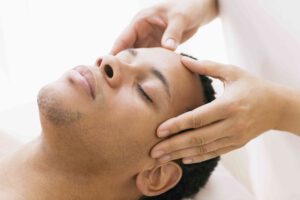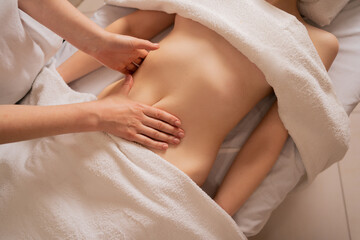What is Massage Therapy?
Massage therapy involves the manipulation of your body’s soft tissue with hands, fingers, forearms, elbows, and knees. Massage Therapist generally relaxes and may help relieve stress.
Massage activates your parasympathetic nervous system, which decreases the fight-or-flight response that can lead to anxiety. There are many different types of massage, each with its benefits.

Massage manipulation of soft tissue stimulates the autonomic nervous system to produce a relaxation response. This causes the heart and breathing rates to slow, blood pressure to decrease, production of stress hormones to reduce and muscles to relax. This allows more oxygen and nutrients to flow to the muscle tissue which can aid in repair, recovery and increased range of motion. Massage also triggers the release of endorphins, serotonin and dopamine which act as neurotransmitters to promote feelings of happiness and to help alleviate depression and anxiety.
When a massage therapist manipulates the skin and connective tissues, it releases tight muscles, tendons and ligaments. This can relieve pain from injury and overuse, and it can improve posture by relieving the tension that can cause spinal misalignment. In addition, massage can also help patients with chronic or temporary conditions such as fibromyalgia, tense and sore muscles, carpal tunnel syndrome, arthritis, back pain, sports injuries, temporomandibular joint dysfunction (TMD), headache and sinus problems.
A massage can help relieve the pain associated with migraines and headaches by reducing stress levels, according to studies. It can also help with other types of headaches and conditions such as neck or jaw pain, menstrual cramps, insomnia, and gastrointestinal disorders. Massage may also be helpful for people with musculoskeletal pain due to pregnancy, fibromyalgia, and chronic back and neck pain.
Massage has been found to boost the immune system by stimulating the production of lymphocytes, which are vital for defending the body against harmful pathogens. It also lowers the level of cortisol, which is a stress hormone that can weaken the immune system. It has also been shown to improve symptoms of fibromyalgia, and for cancer patients it can lift moods and enhance quality of life. It can also lessen the side effects of chemotherapy such as nausea, vomiting and fatigue. However, it’s important for a patient to talk with their healthcare provider before undergoing massage therapy for any condition. Some techniques used during a massage may be too intense for some patients or may not work at all for others.
Massage is widely used to relieve pain from chronic and acute conditions. The manipulation of soft tissues dilates underlying blood vessels and stimulates the body’s natural relaxation response, resulting in decreased heart rate, lower blood pressure, and reduced levels of cortisol (the stress hormone). Massage also releases toxins from the muscles and improves circulation to the heart, skin, organs, and other parts of the body.
Some studies show that massage alleviates certain types of pain, including low back pain, neck pain, headaches and migraines. Those who suffer from arthritis and fibromyalgia also benefit from it, as do those with carpal tunnel syndrome and athletes who use sports massage to improve performance and reduce the risk of injury.
In addition to relieving pain, massage increases the production of white blood cells and the flow of lymph, which removes cellular waste products. It can also help improve bowel movements in those with constipation. Massage may even reduce symptoms of depression and anxiety, such as restlessness and irritability.
The techniques used in a massage differ, but most practitioners use oil or lotion to ease their hands over the client’s skin and apply a series of stroking, kneading, friction and tapping motions. Practitioners also use passive and active stretching to assist with the relaxation of tight muscles. Massage therapists who focus on injury and musculoskeletal problems often incorporate techniques from physiotherapy, osteopathy and chiropractic.
Deep tissue massage, for example, uses slower and more forceful strokes to target deeper layers of muscle and connective tissue. It helps those with sprains, back and neck pain, and chronic aches and pains related to repetitive use and overuse. Sports massage focuses on the specific muscles involved in an athlete’s sport, and trigger point therapy treats tight spots that create referred pain in other parts of the body.
Most people don’t experience any side effects from massage, but it is important to communicate with your therapist if you have cancer or another health condition. For example, if you have osteoporosis, the therapist may need to adjust the amount of pressure they apply to your body. It is also important to drink water after a massage, as you might feel a bit disoriented and thirsty when it is over.
Massage can decrease stress by lowering the heart rate, relaxing muscles and releasing feel good hormones. It has also been shown to reduce cortisol levels and increase serotonin, which is a mood elevator. Additionally, massage may stimulate the hypothalamus-pituitary-adrenal axis to produce hormones that help control and regulate many physiological functions, including blood pressure, respiration, metabolism, and the reproductive system.
The manipulation of soft tissue dilates the underlying blood vessels which stimulates circulation and helps remove cellular waste products, thus helping your body to eliminate waste and toxic substances. This allows nutrient-rich blood to circulate more easily, which promotes the healing of injured tissues and restores normal muscle function. It also enhances your body’s ability to manage pain and discomfort by allowing the release of a natural painkiller called endorphins, which blocks and inhibits painful stimuli from reaching the brain.
One of the most immediate effects of stress is tightening of the muscle groups that creates tension and pain. When these muscles are relaxed they become more flexible and their tone diminishes, creating a feeling of well being and decreasing the impact of emotional stresses on the body.
Studies have indicated that a massage can improve your concentration, focus, and performance, which can be especially helpful for students studying for exams. In fact, taking a short walk between study sessions or incorporating relaxation techniques like yoga into your daily routine can also help reduce stress and anxiety.
In addition, regular exercise is a great way to relieve stress and depression while increasing energy and mood. Find a sport or activity you enjoy and make it a part of your life. Taking frequent breaks throughout the day to get fresh air and recharge is important as well. Set up a schedule for yourself to include a few breaks, and try to stick with it. Make sure you are getting enough sleep, as it is also important for maintaining a healthy lifestyle and alleviating stress. A good night’s rest can help your body naturally combat negative effects of stress, such as high cortisol levels, which are associated with fatigue and depression.
As the body and mind relax during massage, your normal circadian rhythms can return to their restorative state. This helps the body heal, and it can be a key step in overcoming insomnia and sleep disorders.
Poor sleep is associated with a wide range of physical and mental health issues. Insufficient sleep can lead to a weakened immune system, which is why it’s so important to get adequate rest each night. Massage therapy has been shown to promote a healthy sleep cycle by relieving tension, reducing stress and boosting the immune system.
In fact, a recent study found that massage can improve sleep quality and increase the length of time you spend asleep. Specifically, back massage reduced anxiety and improved sleep duration among patients in the intensive care unit (ICU). And research has also shown that massage can help reduce snoring and apnea for people with obstructive sleep apnea.
One possible reason for this is that massage increases the production of serotonin, a neurotransmitter that signals the brain to enter deep sleep. Additionally, studies have found that melatonin levels are increased after massage, and delta waves – the brain waves that appear during the deepest level of sleep – are also elevated.
Another potential way that massage can improve sleep is by improving circulation. When blood flows freely, it can deliver oxygen and nutrients to the cells throughout the body, which can help reduce fatigue and improve sleep. In addition, massage has been found to improve the ability to fall asleep and stay asleep by lowering cortisol, the stress hormone.
Insomnia is an extremely common problem that can be caused by a variety of factors, including high stress levels, pain or illness. Fortunately, there are many different treatment options available to combat insomnia and other sleep problems. Massage is a safe, natural, and effective treatment that can be easily incorporated into your bedtime routine for a better night’s sleep. If you are struggling with insomnia or other sleep disorders, talk to your doctor about how massage may be able to help. Then, consult a licensed massage therapist for the best techniques to incorporate into your daily routine.

